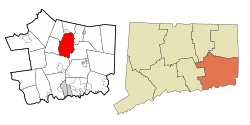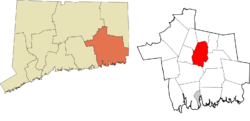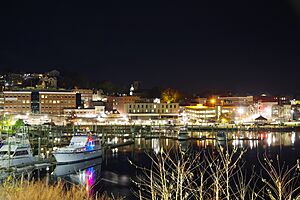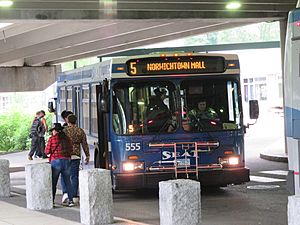Norwich, Connecticut facts for kids
Quick facts for kids
Norwich
|
||
|---|---|---|

|
||
|
||
| Nickname(s):
The Rose Of New England
|
||
 New London County and Connecticut New London County and Connecticut |
||
| Country | ||
| U.S. state | ||
| County | New London | |
| Region | Southeastern CT | |
| Settled | 1659 | |
| Incorporated (city) | 1784 | |
| Consolidated | 1952 | |
| Named for | Norwichtown | |
| Government | ||
| • Type | Council-manager | |
| Area | ||
| • City | 29.41 sq mi (76.16 km2) | |
| • Land | 28.06 sq mi (72.68 km2) | |
| • Water | 1.34 sq mi (3.48 km2) | |
| • Urban | 123.1 sq mi (318.7 km2) | |
| Elevation | 56 ft (17 m) | |
| Population
(2020)
|
||
| • City | 40,125 | |
| • Density | 1,430/sq mi (552.1/km2) | |
| • Metro | 274,055 | |
| GDP | ||
| • Metro | $22.049 billion (2022) | |
| Time zone | UTC−5 (Eastern) | |
| • Summer (DST) | UTC−4 (Eastern) | |
| ZIP Codes |
06360, 06380, 06389
|
|
| Area codes | 860/959 | |
| FIPS code | 09-56200 | |
| GNIS feature ID | 0209410 | |
| Interstates | ||
| State Routes | ||
Norwich (pronounced NOR-wich) is a city in New London County, Connecticut, United States. It's often called "The Rose of New England". Three rivers, the Yantic, Shetucket, and Quinebaug River, meet in Norwich. They form the city's harbor, which then flows into the Thames River and out to Long Island Sound. In 2020, about 40,125 people lived here.
Contents
History of Norwich
Norwich was founded in 1659. It started in an area now called Norwichtown. Settlers from Saybrook Colony bought the land from the Mohegan leader Uncas. One of the founders, Thomas Leffingwell, was famous for helping Uncas.
At first, Norwich was a large area, about nine miles square. Over time, parts of it became new towns. For example, Franklin and Lisbon were once part of Norwich.
By 1694, a public dock was built at the Thames River harbor. This area became known as the Chelsea neighborhood. At first, Norwichtown was the main center for farming. But as shipping and factories grew, the harbor area became more important. By the early 1800s, the city's main center had moved to Chelsea. Today, the original area is called Norwichtown to avoid confusion.
During the 1700s, Norwich started making more of its own goods. This was partly because of the Stamp Act 1765, which made it harder to trade with England. Many mills and factories were built along the rivers. Norwich also played a big part in the American Revolution, providing soldiers and supplies.
Did you know the first recorded use of the word "Hello" was in The Norwich Courier newspaper in 1826? In the 1800s, Norwich became a busy shipping hub. This was helped by steamship service between New York and Boston. During the American Civil War, Norwich's factories grew even more, making textiles and weapons. Railroads, like the Norwich and Worcester Railroad, also helped the city grow. Electric trolleys started running in 1892, connecting Norwich to other towns. The town and city of Norwich officially joined together in 1952.
Norwich Geography
Norwich covers about 76.4 square kilometers (29.4 square miles). Most of this area is land, with about 3.0 square kilometers (1.34 square miles) being water.
Climate in Norwich
Norwich has a changing climate with warm summers and cold winters. Here's a look at the average temperatures and rainfall:
| Climate data for Norwich, Connecticut (1991–2020 normals, extremes 1956–present) | |||||||||||||
|---|---|---|---|---|---|---|---|---|---|---|---|---|---|
| Month | Jan | Feb | Mar | Apr | May | Jun | Jul | Aug | Sep | Oct | Nov | Dec | Year |
| Record high °F (°C) | 70 (21) |
72 (22) |
85 (29) |
94 (34) |
98 (37) |
98 (37) |
101 (38) |
102 (39) |
97 (36) |
88 (31) |
79 (26) |
77 (25) |
102 (39) |
| Mean daily maximum °F (°C) | 37.7 (3.2) |
40.5 (4.7) |
47.8 (8.8) |
59.3 (15.2) |
69.9 (21.1) |
78.4 (25.8) |
84.1 (28.9) |
82.6 (28.1) |
75.5 (24.2) |
63.9 (17.7) |
53.0 (11.7) |
43.2 (6.2) |
61.3 (16.3) |
| Daily mean °F (°C) | 29.5 (−1.4) |
31.7 (−0.2) |
38.6 (3.7) |
49.2 (9.6) |
59.4 (15.2) |
68.4 (20.2) |
74.4 (23.6) |
72.6 (22.6) |
65.2 (18.4) |
53.8 (12.1) |
43.6 (6.4) |
35.1 (1.7) |
51.8 (11.0) |
| Mean daily minimum °F (°C) | 21.2 (−6.0) |
22.9 (−5.1) |
29.4 (−1.4) |
39.1 (3.9) |
48.9 (9.4) |
58.5 (14.7) |
64.8 (18.2) |
62.7 (17.1) |
54.9 (12.7) |
43.6 (6.4) |
34.3 (1.3) |
27.0 (−2.8) |
42.3 (5.7) |
| Record low °F (°C) | −21 (−29) |
−17 (−27) |
−1 (−18) |
17 (−8) |
27 (−3) |
33 (1) |
43 (6) |
40 (4) |
29 (−2) |
18 (−8) |
6 (−14) |
−13 (−25) |
−21 (−29) |
| Average precipitation inches (mm) | 3.89 (99) |
3.75 (95) |
5.09 (129) |
4.71 (120) |
3.64 (92) |
4.27 (108) |
3.63 (92) |
4.41 (112) |
4.79 (122) |
4.86 (123) |
4.17 (106) |
4.97 (126) |
52.18 (1,325) |
| Average snowfall inches (cm) | 9.0 (23) |
7.1 (18) |
5.0 (13) |
0.8 (2.0) |
0.0 (0.0) |
0.0 (0.0) |
0.0 (0.0) |
0.0 (0.0) |
0.0 (0.0) |
0.0 (0.0) |
0.3 (0.76) |
5.6 (14) |
27.8 (71) |
| Average precipitation days (≥ 0.01 in) | 10.8 | 9.6 | 10.4 | 10.8 | 11.3 | 10.1 | 9.4 | 8.7 | 8.6 | 10.3 | 9.3 | 10.9 | 120.2 |
| Average snowy days (≥ 0.1 in) | 3.5 | 3.0 | 2.0 | 0.2 | 0.0 | 0.0 | 0.0 | 0.0 | 0.0 | 0.0 | 0.2 | 2.4 | 11.3 |
| Source: NOAA | |||||||||||||
Norwich Neighborhoods
Norwich has several neighborhoods, each with its own feel. Some of these include Norwichtown, Bean Hill, Yantic, Taftville, Greeneville, Occum, East Great Plains, Thamesville, Laurel Hill, and Chelsea.
Norwich Population and People
| Historical population | ||
|---|---|---|
| Year | Pop. | ±% |
| 1756 | 5,540 | — |
| 1774 | 7,327 | +32.3% |
| 1782 | 7,325 | −0.0% |
| 1800 | 3,476 | −52.5% |
| 1810 | 2,976 | −14.4% |
| 1820 | 2,983 | +0.2% |
| 1830 | 3,135 | +5.1% |
| 1840 | 4,200 | +34.0% |
| 1850 | 6,139 | +46.2% |
| 1860 | 14,048 | +128.8% |
| 1870 | 16,653 | +18.5% |
| 1880 | 15,112 | −9.3% |
| 1890 | 16,156 | +6.9% |
| 1900 | 17,251 | +6.8% |
| 1910 | 20,367 | +18.1% |
| 1920 | 22,304 | +9.5% |
| 1930 | 23,021 | +3.2% |
| 1940 | 23,652 | +2.7% |
| 1950 | 23,429 | −0.9% |
| 1960 | 38,506 | +64.4% |
| 1970 | 41,739 | +8.4% |
| 1980 | 38,074 | −8.8% |
| 1990 | 37,391 | −1.8% |
| 2000 | 36,117 | −3.4% |
| 2010 | 40,493 | +12.1% |
| 2020 | 40,125 | −0.9% |
| Population 1756–2010 | ||
In 2020, Norwich had a population of 40,125 people. The city is a diverse place. In 2012, about 70% of the population was White, 13% Hispanic or Latino, 10% Black or African American, and 8% Asian. Many Chinese Americans have moved to Norwich since 2010.
Arts and Culture in Norwich
The Slater Memorial Museum is a great place to visit. It's located on the campus of the Norwich Free Academy. The museum has art from all over the world, including North and South America, Europe, Asia, and Africa. You can see amazing collections of Asian art and African art. There are also 19th-century American paintings.
Sports in Norwich
Norwich has a history with baseball! The Connecticut Defenders, a minor league baseball team, used to play here. They were a farm team for the San Francisco Giants. Now, the Norwich Sea Unicorns play at Senator Thomas J. Dodd Memorial Stadium. This stadium was even used to film parts of the TV mini-series The Bronx Is Burning.
Parks and Recreation in Norwich
Mohegan Park: Nature and History

Mohegan Park is the biggest park in Norwich. It's a beautiful forested area with lots to do. You can find hiking and biking trails, picnic spots, and places to grill. There's also a beach, basketball courts, and playgrounds. The Rose Garden at the park's entrance is very popular for weddings because it has over a hundred types of roses. The Norwich Free Academy cross country team uses the trails for practice.
The park's main body of water is Spaulding Pond. In 1963, a big flood, known as the Great Norwich Flood, happened when the dam holding back Spaulding Pond broke. This caused a lot of damage to the city. Sadly, some people lost their lives during this flood. The dam has since been rebuilt and improved for safety. Mohegan Park also has a smaller pond called The Skating Pond.
Norwich Ice Rink
The Norwich Municipal Ice Rink is a great place for ice skating and hockey. It has a large ice surface and locker rooms. The Rose City Warriors, a senior women's ice hockey team, play here. Many local high school teams also call this rink home.
Education in Norwich
For younger students, Norwich has its own public schools for elementary and middle school. The middle schools are Teachers' Memorial Global Studies Middle School and Kelly STEAM Magnet Middle School. There's also the Integrated Day Charter School, which offers a different learning style.
For high school, most students in Norwich and nearby towns go to the Norwich Free Academy. This is a special independent school. Another option is Norwich Technical High School, which teaches students job skills along with regular subjects. For older students, Three Rivers Community College is also in the area.
Norwich Economy
Norwich has many different businesses that provide jobs for its residents. Here are some of the top employers in the city:
| # | Employer | # of Employees |
|---|---|---|
| 1 | William W. Backus Hospital | 1,895 |
| 2 | City of Norwich | 1,212 |
| 3 | State of Connecticut | 944 |
| 4 | Bob's Discount Furniture | 553 |
| 5 | Norwich Free Academy | 345 |
| 6 | U.S. Food Services | 300 |
| 7 | United Community & Family Services | 276 |
| 8 | Nordson EFP | 270 |
| 9 | The American Group | 219 |
| 10 | ShopRite | 180 |
Norwich Transportation
Public transportation in Norwich is provided by Southeast Area Transit (SEAT). The main bus station is the Norwich Transportation Center. You can also catch buses here to other towns like Willimantic, CT and Putnam, CT.
Norwich used to have a train station downtown, which is now an office for The Norwich Bulletin newspaper. Freight trains still use the tracks today. If you want to travel by passenger train, the closest station is in New London, CT. For air travel, the nearest airports are Bradley International Airport and Rhode Island T. F. Green International Airport. There are also talks about bringing passenger train service back to Norwich in the future.
Notable People from Norwich
- Benedict Arnold (1741–1801), a famous general from the American Revolutionary War. He was born in Norwich.
- Grover Cleveland (1837–1908), a former U.S. President, his father, Richard Falley Cleveland, was born and raised in Norwich.
- Rajai Davis (born 1980), a professional baseball player.
- Thomas J. Dodd (1907–1971), a U.S. Senator and Representative.
- Charlotte Perkins Gilman (1860–1935), a well-known author and social reformer, lived in Norwich for a short time.
- Samuel Huntington (1731–1796), a signer of the Declaration of Independence and the first President of the United States under the Articles of Confederation.
- Paul Konerko (born 1976), a former Major League Baseball player.
- Wally Lamb (born 1950), a popular author.
- Edwin H. Land (1909–1991), the inventor of the Polaroid camera.
- E. Annie Proulx, a journalist and author, born in Norwich.
- Edith Roosevelt (1861–1948), the second wife of President Theodore Roosevelt, was born in the city.
- Albert Schatz (1929–2005), a microbiologist who discovered the important medicine streptomycin.
- Horace Smith (1808–1893), who partnered with Daniel B. Wesson to create the first repeating rifle. They later founded Smith & Wesson.
See also
 In Spanish: Norwich (Connecticut) para niños
In Spanish: Norwich (Connecticut) para niños







